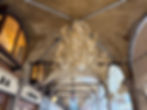- Caterina
- 5 days ago
- 1 min read
Every year during the Christmas season, a magical atmosphere fills Piazza San Marco in Venice. In the last couple of years, the northern side of the square, along the Procuratie Vecchie, has been illuminated by magnificent chandeliers that resemble those found in elegant Venetian palaces. These unique installations bring warmth and elegance to the square, transforming it into an open-air salon and creating a memorable holiday experience for visitors.

The chandeliers are crafted by renowned Venetian glassmasters, whose artistry is famous around the world. Each piece has its own personality: different colors, shapes and dimensions, reflecting the centuries-old tradition of Murano glassmaking. Some are delicate and transparent, others rich and vibrant, but all of them shine beautifully when the lights of the evening are reflected on the wet stones of the square after a light winter rain.

These installations have quickly become one of Venice’s most beloved seasonal attractions. Locals and tourists alike stop to admire them, take photos and enjoy the unique combination of art, light and history. They do not only celebrate Christmas, but also highlight the enduring craftsmanship of Venice, where beauty and creativity continue to illuminate the city—especially in the heart of winter.











